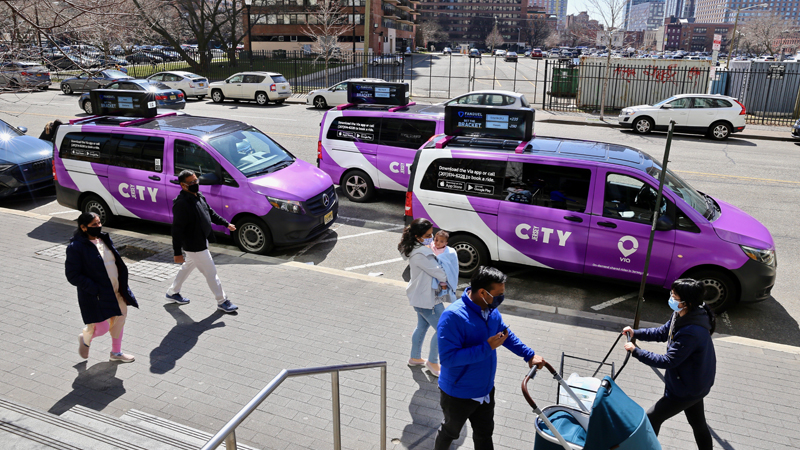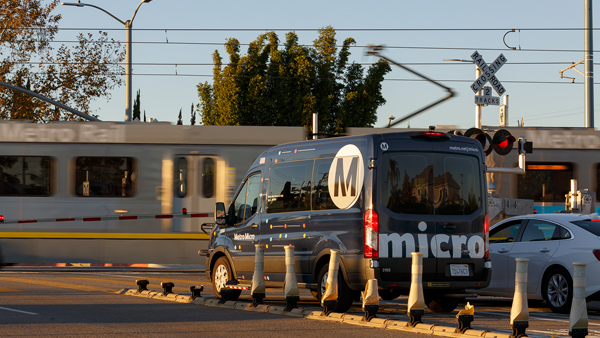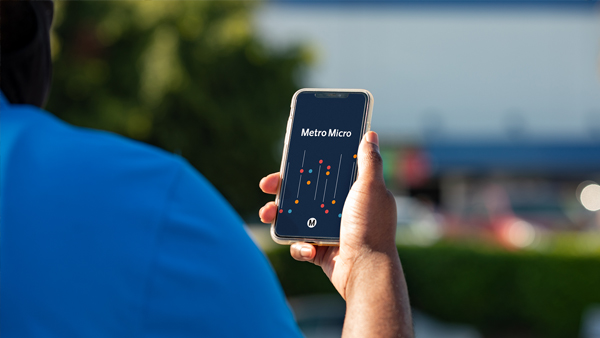November 14, 2022

The New York City-based transportation company Via contracts with agencies to provide microtransit services in more than 200 markets globally. Via
On any weekday in certain parts of west Los Angeles, an eager commuter can start anywhere from a multimillion-dollar mansion to a modest rental apartment, consult a GPS-enabled app, and request a ride to a number of useful destinations. Perhaps an office. Perhaps the campus of nearby UCLA. Or perhaps a light rail station, serving the region’s relatively new Expo Line. If all goes well, the ride will arrive within a few minutes, and the trip will be direct.
For this service, the passenger—whether billionaire, student, blue-collar worker—will pay exactly $1. The return trip: same procedure, same price.
At one-third the price of a coffee, this service is provided by neither Uber nor Lyft, the Silicon Valley-based behemoths that have made app-enabled ridesharing ubiquitous, but, especially with “surge” pricing and all sorts of surcharges, far from cheap. Nonetheless, these services have been accused, with varying degrees of validity, of undermining public transit in many cities, siphoning off discretionary riders willing to pay for convenience.
Similar to dozens of other services emerging across the country, Metro Micro is the Los Angeles County Metropolitan Transportation Authority's way of marrying the convenience of app-based rides with the mission-driven motivation of public transit. Late though they may be to ride-hailing, public transit agencies have rolled out “microtransit” services in recent years, representing arguably this generation’s greatest innovation in public transit. Most microtransit services rely on medium-sized vans that, rather than adhere to fixed routes the way buses do, serve cordoned regions within cities or transit agencies’ jurisdictions. They attempt to marry the efficiency of vanpooling with the convenience of ride-hailing and the relatively low user costs of large-scale public transit. “In technical terms, microtransit is demand-responsive transit,” said Ali Kothwala, a researcher at the Institute of Transportation Studies at the University of California at Davis.
“Typically, when you think about transit, you think about frequency, headways. The routes are pretty much scheduled, you show up at a bus stop or transit station, it will take you to a certain destination,” Kothwala said. “Microtransit changes the landscape a bit. It merges demand-responsiveness (with) … decid(ing) where you want to go, as long as it’s within a service area.”
In addition to Metro Micro, which started in late 2020, microtransit services include MARTA’s Reach in the Atlanta region, Albany’s FLEX service in New York, and Via Jersey City in New Jersey, among many others. Some have even arisen in low-density rural areas and on at least one Native American reservation, the Blackfeet Reservation in Montana, that otherwise have no public transportation options.
The New York City-based transportation company Via, which contracts with many agencies to provide microtransit services (including rolling stock and/or app and deployment technologies), estimates that it now serves more than 200 markets globally, with more on the way.
“We’re seeing a lot of ridership growth, almost across the board,” said Via Co-Chief Operating Officer Alex Lavoie. “I don’t think we’ve ever felt so optimistic about how important microtransit can be as a component of the public transit strategy of cities in the U.S. and across the world.”
Microtransit services are typically designed to achieve one of three goals, or a combination thereof. They can serve neighborhoods and populations that are underserved by conventional transit, including fixed-route bus lines and trains. They can reach areas where rider demand and/or street configurations, such as hills or curves, make fixed-route buses inefficient or entirely infeasible.
“Either you want this to serve as feeders or a substitute to shorter trips made by cars,” Kothwala said. “You could have multiple goals and objectives … and your metrics would vary based on that.”
Microtransit can also serve an agency’s traditional modes through first- and last-mile connections, enabling riders to make their way to and from bus and rail lines that might otherwise be prohibitively far away—or that might require dangerous or unpleasant walks in inclement weather or through areas that are perceived as dangerous. Likewise, operating hours can matter as much as geography, with microtransit serving some passengers after dark when safety concerns are heightened.

In addition to Metro Micro, which started in late 2020, microtransit services include MARTA’s Reach in the Atlanta region, FLEX in Albany, New York, and Via Jersey City in New Jersey. Micro Metro
“People can use it to supplement how they’re traveling,” said Anthony Thomas, program manager for MARTA Reach. “It’s difficult in a place like Atlanta. The terrain might be difficult. It’s sometimes really hot, sometimes really rainy. Having a service that allows them to simplify that first part of it has been hugely important.”
And the microtransit systems can encourage transit ridership.
“The majority of origins and destinations tie back into our fixed route network,” said Rani Narula-Woods, who oversees L.A.’s Metro Micro. “As we continue to expand the public footprint of mass transit, I think we’ll continue to see that bump in connectivity between Metro Micro and other services.”
Systems are typically designed to operate within relatively small geographic regions, both to achieve operational efficiency, with vans operating like circulators, and to target the three goals. The eight zones served by Metro Micro are up to about 30 square miles and are spread throughout the city of Los Angeles and several neighboring jurisdictions—covering only a fraction of Metro's service area but, according to Metro officials, serving key groups of riders.
Likewise, the pilot plan for MARTA Reach includes four zones, including urban and suburban areas. The zones were designed to serve different demographic groups in part to be able to compare data. “We started from not really knowing a lot about how our riders might want to interact with on-demand transit,” Thomas said. “We didn’t know if it would be people who are walking long distances to use our services now or people that don’t currently use MARTA.”
“We chose the zones to see how the service operated in different areas and communities,” said Thomas.
By contrast, Jersey City itself is smaller than any of these big-city zones, so Via’s service areas cover the entire city. Though Jersey City is served by several transit agencies, including the Port Authority of New York and New Jersey’s PATH and NJ TRANSIT buses and light rail, Via Jersey City is the only service run by the city and designed expressly for its residents and other stakeholders. It’s meant to address areas of the city underserved by transit, with rides beginning and ending in a central zone that includes downtown and near transit centers at a flat rate of $2, and anywhere within an outer zone for another $0.50 per mile fee.
The City of Wilson, North Carolina, took things a step further than Jersey City: it scrapped its entire five-route bus system in favor of citywide microtransit in 2020. The city reports that, as of this June, it was serving 3,700 passengers per week, which is more than double the number served by Wilson’s old bus system.
Not every service charges as little as $1 (which may yet turn out to be a promotional rate for Los Angeles Metro), but most services charge rates in line with their respective fares for traditional bus and rail routes. Whatever passengers pay, farebox recovery is almost always negligible compared to the cost of running what is, essentially, Uber or Lyft but funded by tax dollars rather than venture capital money.
No agencies interviewed for this article disclosed their per-rider costs but most insisted that microtransit should not necessarily be judged according to those metrics. The costs and operations of microtransit are more akin to those of paratransit than of fixed-route buses. Kothwala estimates that some microtransit services cost more than twice per mile what paratransit does, but costs are falling as agencies refine their operations.
However, agencies are required to provide paratransit for passengers with physical limitations, whereas microtransit is, essentially, elective. “Paratransit is currently viewed as something that you’re mandated to provide. You’re not mandated to provide microtransit,” Kothwala said.
Microtransit can compare favorably if a fixed-route service obviates the need for a new route, or, in the case of Wilson, enables a city to eliminate traditional public transit entirely.
“It’s all relative,” said Anne Brown, professor of Community and Regional Planning at the University of Oregon. “It’s much more expensive than a really efficient bus or rail line that goes down a central corridor with a lot of density. On a per-ride basis, it’s much more expensive than a fixed-route … it’s probably less expensive than, say, operating a full bus in the deep suburbs with two passengers per hour.”
For some agencies, though, expense is almost beside the point. Many microtransit zones, especially in large cities, are designed to promote social equity, serving populations that are marginalized or heavily dependent on transit.

Eight zones served by Metro Micro are up to about 30 square miles, spread throughout Los Angeles. Micro Metro
Agencies are paying close attention to data to determine whether to make microtransit permanent. MARTA has partnered with Georgia Tech to both implement its pilot projects and evaluate their efficacy.
Sometimes, though, all the data in the world is not as useful as a single TikTok video. In April, comedian Adam Conover — known for a quippy video series called “Adam Ruins Everything” that demystifies various social ills—told his 1.4 million TikTok followers how much he, as a Los Angeles resident without a car, appreciates Metro Micro. He called it the “best public transpiration app ever.” The video received more than 262,000 “hearts” and presumably boosted Metro Micro ridership.
Even when influencers don’t give transit agencies free advertising, marketing and promotion can be, agency officials say, crucial to the success of a microtransit program. Even if would-be riders are familiar with buses and with app-based rideshare services, they do not necessarily have an intuitive understanding of microtransit.
“It’s something new,” Kothwala said. “People are used to showing up at a stop and expecting a bus or a train to show up. Spotting a Metro Micro—not so much.”
MARTA used a variety of outreach and advertising methods to promote Reach, which ended, as scheduled, in August. Thomas said the agency used everything from traditional posters and direct mailers to street teams, pop-up events at stations, and giveaways of branded Reach transit cards to attract a wide variety of riders.
“It’s really important that people understand that the service is for them,” Thomas said. “People might see that there’s a service for ‘someone else’ or it might be for people with disabilities or a specialized service. In your communication, you need to explain that it’s open to the public, anyone can ride it, it is fully incorporated into the broader system.”
Ever since the advent of app-based ride hailing, companies like Uber and Lyft have been accused of eating into public transit’s market share. Whether microtransit will lure meaningful numbers of discretionary riders back, even at fares as low as $1, remains to be seen. But that’s not necessarily the goal, nor is it the driving force behind microtransit’s proliferation.
“I don’t see it as direct competition” to ride-hailing services, Narula-Woods said. “We don’t expect people to be exclusively Micro riders. For us, it’s about how can we become a regular part of what you do each week than can we replace a single mode?”
Josh Stephens is a freelance writer based in Los Angeles.